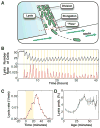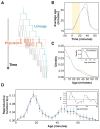Quantifying selective pressures driving bacterial evolution using lineage analysis
- PMID: 26213639
- PMCID: PMC4511495
- DOI: 10.1103/PhysRevX.5.011016
Quantifying selective pressures driving bacterial evolution using lineage analysis
Abstract
Organisms use a variety of strategies to adapt to their environments and maximize long-term growth potential, but quantitative characterization of the benefits conferred by the use of such strategies, as well as their impact on the whole population's rate of growth, remains challenging. Here, we use a path-integral framework that describes how selection acts on lineages -i.e. the life-histories of individuals and their ancestors- to demonstrate that lineage-based measurements can be used to quantify the selective pressures acting on a population. We apply this analysis to E. coli bacteria exposed to cyclical treatments of carbenicillin, an antibiotic that interferes with cell-wall synthesis and affects cells in an age-dependent manner. While the extensive characterization of the life-history of thousands of cells is necessary to accurately extract the age-dependent selective pressures caused by carbenicillin, the same measurement can be recapitulated using lineage-based statistics of a single surviving cell. Population-wide evolutionary pressures can be extracted from the properties of the surviving lineages within a population, providing an alternative and efficient procedure to quantify the evolutionary forces acting on a population. Importantly, this approach is not limited to age-dependent selection, and the framework can be generalized to detect signatures of other trait-specific selection using lineage-based measurements. Our results establish a powerful way to study the evolutionary dynamics of life under selection, and may be broadly useful in elucidating selective pressures driving the emergence of antibiotic resistance and the evolution of survival strategies in biological systems.
Figures




Similar articles
-
A unified framework for measuring selection on cellular lineages and traits.Elife. 2022 Dec 6;11:e72299. doi: 10.7554/eLife.72299. Elife. 2022. PMID: 36472074 Free PMC article.
-
Planning Implications Related to Sterilization-Sensitive Science Investigations Associated with Mars Sample Return (MSR).Astrobiology. 2022 Jun;22(S1):S112-S164. doi: 10.1089/AST.2021.0113. Epub 2022 May 19. Astrobiology. 2022. PMID: 34904892
-
Fungal Evolution in Anthropogenic Environments: Botrytis cinerea Populations Infecting Small Fruit Hosts in the Pacific Northwest Rapidly Adapt to Human-Induced Selection Pressures.Appl Environ Microbiol. 2020 Apr 17;86(9):e02908-19. doi: 10.1128/AEM.02908-19. Print 2020 Apr 17. Appl Environ Microbiol. 2020. PMID: 32086310 Free PMC article.
-
Evolutionary Trajectories to Antibiotic Resistance.Annu Rev Microbiol. 2017 Sep 8;71:579-596. doi: 10.1146/annurev-micro-090816-093813. Epub 2017 Jul 11. Annu Rev Microbiol. 2017. PMID: 28697667 Review.
-
How frequency-dependent selection affects population fitness, maladaptation and evolutionary rescue.Evol Appl. 2018 Oct 26;12(7):1243-1258. doi: 10.1111/eva.12714. eCollection 2019 Aug. Evol Appl. 2018. PMID: 31417612 Free PMC article. Review.
Cited by
-
Intercellular Variability in Protein Levels from Stochastic Expression and Noisy Cell Cycle Processes.PLoS Comput Biol. 2016 Aug 18;12(8):e1004972. doi: 10.1371/journal.pcbi.1004972. eCollection 2016 Aug. PLoS Comput Biol. 2016. PMID: 27536771 Free PMC article.
-
Experimental Design, Population Dynamics, and Diversity in Microbial Experimental Evolution.Microbiol Mol Biol Rev. 2018 Jul 25;82(3):e00008-18. doi: 10.1128/MMBR.00008-18. Print 2018 Sep. Microbiol Mol Biol Rev. 2018. PMID: 30045954 Free PMC article. Review.
-
Robust, linear correlations between growth rates and β-lactam-mediated lysis rates.Proc Natl Acad Sci U S A. 2018 Apr 17;115(16):4069-4074. doi: 10.1073/pnas.1719504115. Epub 2018 Apr 2. Proc Natl Acad Sci U S A. 2018. PMID: 29610312 Free PMC article.
-
Antibiotic resistance: a physicist's view.Phys Biol. 2016 Aug 11;13(4):045001. doi: 10.1088/1478-3975/13/4/045001. Phys Biol. 2016. PMID: 27510596 Free PMC article.
-
Growth-dependent heterogeneity in the DNA damage response in Escherichia coli.Mol Syst Biol. 2022 May;18(5):e10441. doi: 10.15252/msb.202110441. Mol Syst Biol. 2022. PMID: 35620827 Free PMC article.
References
Grants and funding
LinkOut - more resources
Full Text Sources
